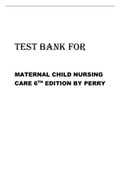TEST BANK FOR
MATERNAL CHILD NURSING
CARE 6TH EDITION BY PERRY
, Table of Contents
Table of Contents 1
Chapter 01: 21st Century Maternity Nursing 3
Chapter 02: Community Care: The Family and Culture 17
Chapter 03: Assessment and Health Promotion 27
Chapter 04: Reproductive System Concerns 44
Chapter 05: Infertility, Contraception, and Abortion 65
Chapter 06: Genetics, Conception, and Fetal Development 83
Chapter 07: Anatomy and Physiology of Pregnancy 99
Chapter 08: Nursing Care of the Family During Pregnancy 114
Chapter 09: Maternal and Fetal Nutrition 131
Chapter 10: Assessment of High Risk Pregnancy 148
Chapter 11: High Risk Perinatal Care: Preexisting Conditions 162
Chapter 12: High Risk Perinatal Care: Gestational Conditions 182
Chapter 13: Labor and Birth Processes 204
Chapter 14: Pain Management 217
Chapter 15: Fetal Assessment During Labor 234
Chapter 16: Nursing Care of the Family During Labor and Birth 252
Chapter 17: Labor and Birth Complications 276
Chapter 18: Maternal Physiologic Changes 293
Chapter 19: Nursing Care of the Family During the Postpartum Period 307
Chapter 20: Transition to Parenthood 321
Chapter 21: Postpartum Complications 336
Chapter 22: Physiologic and Behavioral Adaptations of the Newborn 354
Chapter 23: Nursing Care of the Newborn and Family 373
Chapter 24: Newborn Nutrition and Feeding 385
Chapter 25: The High Risk Newborn 402
Chapter 26: 21st Century Pediatric Nursing 426
Chapter 27: Family, Social, Cultural, and Religious Influences on Child Health Promotion
433
Chapter 28: Developmental and Genetic Influences on Child Health Promotion 441
Chapter 29: Communication, History, and Physical Assessment 456
Chapter 30: Pain Assessment and Management in Children 476
Chapter 31: The Infant and Family 487
Chapter 32: The Toddler and Family 509
Chapter 33: The Preschooler and Family 527
Chapter 34: The School-Age Child and Family 541
Chapter 35: The Adolescent and Family 557
Chapter 36: Impact of Chronic Illness, Disability, and End-of-Life Care for the Child and
Family 578
Chapter 37: Impact of Cognitive or Sensory Impairment on the Child and Family 595
Chapter 38: Family-Centered Care of the Child During Illness and Hospitalization 614
Chapter 39: Pediatric Variations of Nursing Interventions 626
Chapter 40: Respiratory Dysfunction 648
Chapter 41: Gastrointestinal Dysfunction 666
Chapter 42: Cardiovascular Dysfunction 688
Chapter 43: Hematologic and Immunologic Dysfunction 713
Chapter 44: Cancer 736
Chapter 45: Genitourinary Dysfunction 758
Chapter 46: Cerebral Dysfunction 774
Chapter 47: Endocrine Dysfunction 795
Chapter 48: Musculoskeletal or Articular Dysfunction 811
,Chapter 49: Neuromuscular or Muscular Dysfunction 827
, Chapter 01: 21st Century Maternity Nursing
MULTIPLE CHOICE
1. When providing care for a pregnant woman, the nurse should be aware that one of the most frequently
reported maternal medical risk factors is:
a. Diabetes mellitus. c. Chronic hypertension.
b. Mitral valve prolapse (MVP). d. Anemia.
ANS: A
The most frequently reported maternal medical risk factors are diabetes and hypertension associated with
pregnancy. Both of these conditions are associated with maternal obesity. There are no studies that indicate
MVP is among the most frequently reported maternal risk factors. Hypertension associated with pregnancy,
not chronic hypertension, is one of the most frequently reported maternal medical risk factors. Although
anemia is a concern in pregnancy, it is not one of the most frequently reported maternal medical risk factors in
pregnancy.
PTS: 1 DIF: Cognitive Level: Knowledge REF: 6
OBJ: Nursing Process: Assessment MSC: Client Needs: Physiologic Integrity
2. To ensure optimal outcomes for the patient, the contemporary maternity nurse must incorporate both
teamwork and communication with clinicians into her care delivery, The SBAR technique of communication is
an easy-to-remember mechanism for communication. Which of the following correctly defines this acronym?
a. Situation, baseline assessment, response
b. Situation, background, assessment, recommendation
c. Subjective background, assessment, recommendation
d. Situation, background, anticipated recommendation
ANS: B
The situation, background, assessment, recommendation (SBAR) technique provides a specific framework for
communication among health care providers. Failure to communicate is one of the major reasons for errors in
health care. The SBAR technique has the potential to serve as a means to reduce errors.
PTS: 1 DIF: Cognitive Level: Comprehension REF: 14
OBJ: Nursing Process: Assessment, Planning
MSC: Client Needs: Safe and Effective Care Environment
3. The role of the professional nurse caring for childbearing families has evolved to emphasize:
a. Providing care to patients directly at the bedside.




